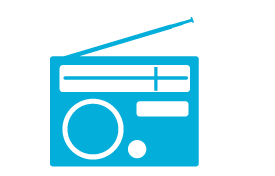As demand for new mobile services grow, can the UK’s limited radio frequencies keep up with technological development? Or will there be a serious shortage of RF space in the very near future?
The last 15 years have seen an explosion of mobile technologies. Smartphones, TV channels, wireless internet and mobile data, all requiring a chunk of the mobile spectrum, but with a relative finite amount of space how much more can it hold?
What is the Wireless Spectrum?
All wireless signals travel through the air, via radio frequencies known as ‘the spectrum’. These invisible airwaves transfer the data needed to hear a radio station or watch a TV channel.
Every device that uses wireless technology, like Smartphones, radios or TV’s use part of the spectrum. Their own little chunk of radio frequency (RF) so that their signal is clear and unblocked.
The simplest way to think of the spectrum is to look at a FM radio. If you tune your radio to 88.6 FM, you’ll receive the station that is broadcasting at 88.6 megahertz. The signal would be clear (hopefully) and uninterrupted. If you want to move over to another station you might jump to 101.2 to hear something different. No two stations would transmit over the same spectrum at the same time because they’d interfere with each other.
Wireless signals transmit over a varied distances, with some frequencies stronger than others. The low-middle frequencies like old Analogue TV’s 800MHz, can currently travel much further than your High Frequency WiFi router of 2.4GHz.
Why is Space an Issue?
It’s not just your TV signal that could be in danger, everything we use that works on a RF is chipping away at the greater spectrum meaning there is a higher chances of a crossed signal.
Sound recordist Will Jefferson works closely with wireless radio frequencies whilst on set, he believes there is a serious backlash waiting for us when we run out of space.
“Working as a Location Sound Recordist, we use various wireless technologies daily. Some days everything works great and the wireless spectrum is clear and crisp. Other days, usually in larger cities, we battle to find enough empty space because there’s so much traffic on the radio waves.”
“This problem seems to be increasing and from what I hear from my American colleagues, who have an even bigger problem than us, will only get worse unless we find a solution.”
TV
TV is currently the most talked about issue when it comes to RF spectrum, as it uses a large proportion of valuable RF space.
In 2012 the UK officially ‘switched off’ its analogue TV signal to be replaced by digital TV. This freed up the valuable 800MHz range, the subsequent space was sold off by the government to create the UK’s new 4G Network. The 800MHz spectrum was particularly valuable due to its long-range capabilities, which allows operators to broadcast over a larger range with less equipment instead of using multiple broadcasting stations.
TV broadcasters fear they will be squeezed out of their frequencies so that other wireless providers can use the spectrum.
Can’t we just add more frequencies?
The frequency spectrum, although wide ranging, is actually restricted by the technologies we use to broadcast and receive. Although we’re progressing with technological development, we can only currently use a finite amount of the spectrum available
Over time we’ve become better at using more of the spectrum. 50 years ago 800MHz was considered an “ultra-high frequency” (UHF), however, with the technological progression we’re now above the 5GHz range.
Higher frequencies can pose other difficulties: The higher they go, the ‘weaker’ the signal gets meaning less distance they can travel. Where 600MHz can travel miles, 2.5 GHz will only travel meters and 5GHz will broadcast half of that.
So naturally some frequencies are worth much, much more than others.
What’s the plan?
Evolutions in UHF’s to free up lower space has been successful. However, as mentioned before high frequencies do not travel the long distances required for national coverage.
Developing more efficient and sensitive technologies would go a long way to helping the process, but engineers haven’t quite plucked any stable concepts out of the air just yet.
The most exciting idea currently being tested is ‘the Vortex’. Currently still in its early stage, the Vortex concept would allow broadcasters to simultaneously transmit multiple radio channels over exactly the same wireless frequency. This would mean we could have an infinite number of broadcasts on one frequency, freeing up an infinite amount of space.
For the time being the RF spectrum is one very valuable piece of thin air. It’s almost guaranteed we will see battles over the next few years as we develop into 5G and more wireless technologies.



























